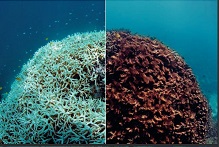 Back on 17 March, 2017 Joshua Robertson’s article in the Guardian Stopping global warming is only way to save Great Barrier Reef, scientists warn reported four things happening simultaneously. First, a paper by 46 scientists published in Nature showed that bleaching of the Great Barrier Reef in 1998, 2002 and 2016 was determined by ocean surface temperature; water quality had nothing to do with it.
Back on 17 March, 2017 Joshua Robertson’s article in the Guardian Stopping global warming is only way to save Great Barrier Reef, scientists warn reported four things happening simultaneously. First, a paper by 46 scientists published in Nature showed that bleaching of the Great Barrier Reef in 1998, 2002 and 2016 was determined by ocean surface temperature; water quality had nothing to do with it.
Secondly, Terry Hughes, the lead author of the paper was embarking on aerial surveys to chart the effects of the latest 2017 bleaching event, the first in consecutive years, and the first in a non-El Niño year.
Third, Queensland government officials were in Paris meeting with UNESCO officials to appeal for more time to make good on conservation efforts to ward off an “in-danger” listing for the reef. This conservation plan does not mention global warming, concentrating on such things as water quality.
Fourth, Queensland premier Annastacia Palaszczuk went to India to lobby Adani to proceed with its giant coal mine in the Galilee Basin.
In other words, global warming is the main danger to the reef, being manifest at current levels, while politicians chase water quality and direct their efforts to making global warming worse through producing more coal.
The Hughes research paper found that 91% of coral on the reef had suffered from bleaching over the past two decades. In 2016, 22% of the Reef was killed off in one hit.
I’ve been citing a 2011 study by K. Frieler et al which found that:
- preserving more than 10 per cent of coral reefs worldwide would require limiting warming to below +1.5°C (atmosphere–ocean general circulation models (AOGCMs) range: 1.3–1.8°C) relative to pre-industrial levels.
Then in December last year a new report led by researchers at the National Oceanic and Atmospheric Administration (NOAA) found that if current trends continue, by 2050 more than 98% of reefs world-wide are expected to be exposed to bleaching-level thermal stress in each year. Reefs need 10-15 stress-free years to recover, if they are going to at all, and proximity to other healthy reefs is important.
Some reefs in the world appear to have gone forever. As Jules Howard reports:
- Of 21 reefs monitored by scientists in the Seychelles, for instance, 12 have since recovered after a coral bleaching episode in 1998. (The other nine? Now seaweed-covered ruins.)
There is more on coral reef resilience in this post last year, but in general terms it takes years for any regrowth to show, and frequent bleaching will be terminal. Then there is acidification.
The Hughes et al paper shows the footprint of the 1998, 2002 and 2016 events, with red representing greater than 60% bleached:
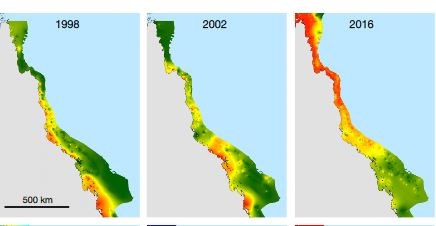
This article shows the 2017 bleaching compared to 2016:
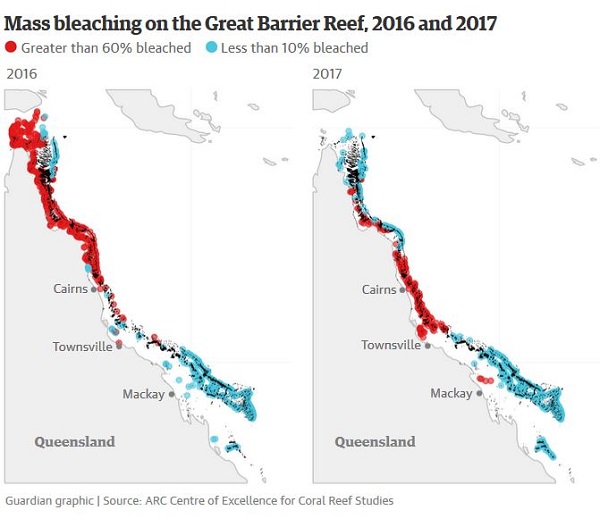
This image from a recently published Climate Council report Climate Change: A Deadly Threat To Coral Reefs shows the coral death rate after the 2016 bleaching:
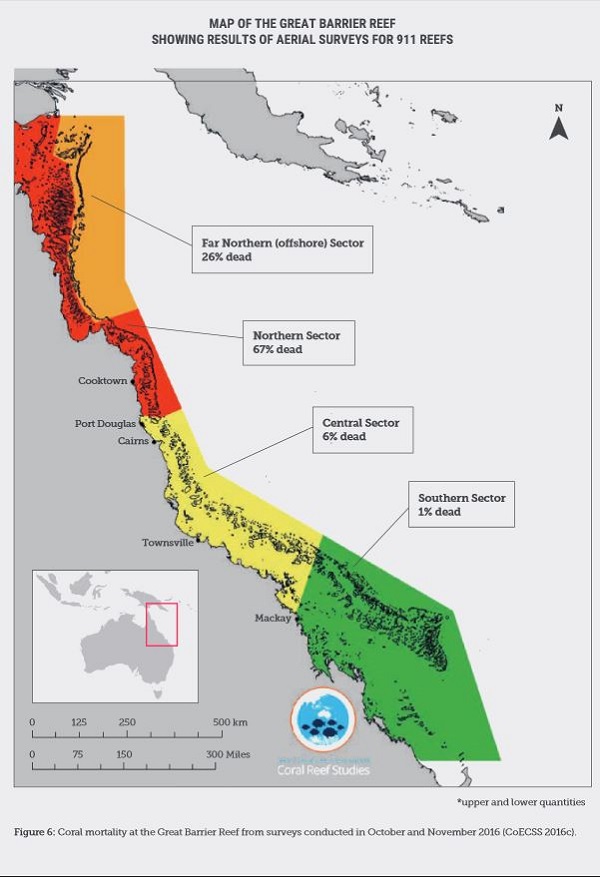
In the Far Northern and Northern sectors there is virtually no runoff from farms and other activity on land. Coral damage reflects ocean water temperature.
Just to remind you, from the post Great Barrier Reef will never be the same, here’s what bleaching does:
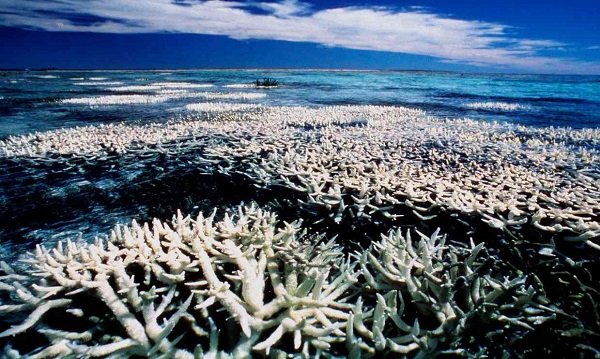
This is what a really healthy reef looks like:
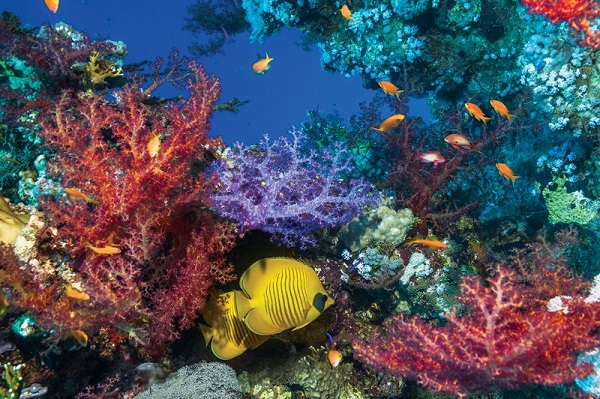
This is a before and after showing dead coral:

The Climate Council report tells us that the great Barrier reef supports the livelihoods of 69,000 Australians and is worth $7 billion annually to the economy. Globally, the economic figure is $1 trillion and the livelihoods supported number 500 million.
For dangerous climate change we do not have to wait for warming to reach 2°C or 1.5°C. It’s happening now.
For other posts, see Tag Archives: Great Barrier Reef and specifically:

I think we could re-title this post as “Do our politicians really want to save our reef?”
Clearly not I can’t help thinking. Here’s a bit more on our premieres Indian trip where she hauled along eight regional mayors, resplendent in ridiculous blue hats, doubtless intending to show great regional support for the Adani project. http://www.abc.net.au/news/2017-03-18/adani-mine-support-shown-by-qld-premier-mayors-in-india/8366126
Since that trip Adani has been given unlimited access for 60 years to ground waters. No limit.
Then we had Turnbull practically humping Adani as he fawned he way towards one of the most destructive projects possible. And ironically considering a $900 million loan from our “Future Fund” to grease the way forward.
No, clearly at State and Federal level our politicians are not about saving the reef, nor from the prospects of global warming. Their on-going deceit is culpable: they are intentionally obstructing the pathways that offer some hope that we may avoid +2C. And when they retire or get flicked, they’ll get their superannuation and having done their part to destroy the planet, none of them will go to goal.
I hope the history books come down hard on them.
Aparently the Adani company is, according to comments aired on TV over the weekend, a Caymens registered company, so it a con from the beginning and nothing at all to do with the Indian people. Australia is participating in, and considering lending to a money laundering operation. And all of the Australian politicians lending support to it need to be carefully scrutinised for illegal money laundering connections.
The link to one article on this
http://www.abc.net.au/news/2017-03-14/adani-carmichael-coalmine-to-shift-millions-to-cayman-islands/8350704
Australia should have nothing to do with this.
For the reef we need to be creating artificial reefs in safe locations to keep a local stock of reef cultures alive until sea level rise can assist with temperature moderation, if that is a prospect.
Given the damage that has already been done to the reef in addition to the damage to gulf mangroves and the damage to kelp forrests the real question may unfortunately be “Can we save the reef?” not “Do we seriously want to save the great barrier reef.”
Perhaps some corals may adapt and survive or we can start seeding new reefs further South but it is hard not to be a reef pessimist these days even if we accept the possibilities that governments will get serious about climate action.
Coral reefs have been around for hundreds of millions of years. I believe after the Permian–Triassic extinction event, colloquially known as the Great Dying 252 million years ago, reefs took about 4 million years to re-establish themselves. In the future they will presumably recolonise from deep water and temperate corals, which do exist. It’s a long time to wait, however.
I also worry about coral reef fish species.
Brian: Specialist species will be the ones that are most at risk.
Cloud brightening suggested as a way to cool the reef.
It is wishful thinking to suggest that we could reduce greenhouse emissions quickly enough to save the reef. Alternatives need to be considered.
Very true John, and not a truth we want. Our atmosphere will continue to warm even if we stabilise emissions to what we call safe. That’s due to “Inertia in Climate Systems”. See
http://www.ipcc.ch/ipccreports/tar/vol4/011.htm
That is an older IPCC (2001) report but I don’t think there has been a shift in the thinking since then.
John, yes I agree we do need to think of alternatives. The outcome of this seaso’s bleaching will be not known until we see later this year how much of the Reef dies, but it looks as though two-thirds of the whole reef system has been seriously damaged.
Geoff, “inertia” is a good term. As I said in my last post on the Arctic, current models used by the IPCC don’t take in things like albedo changes from ice melt and loss of snow cover, or ice sheet degradation.
It’s a fair bet that if we hit zero emissions next week the inertia in the system would still take us past two degrees.